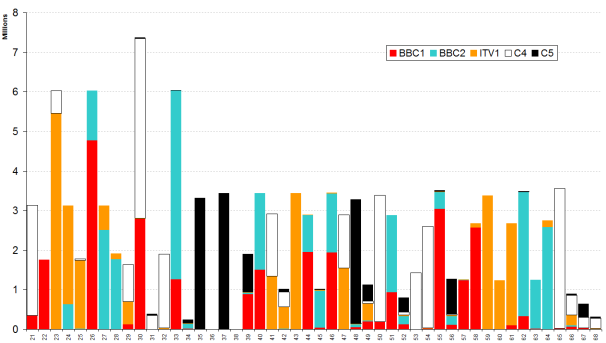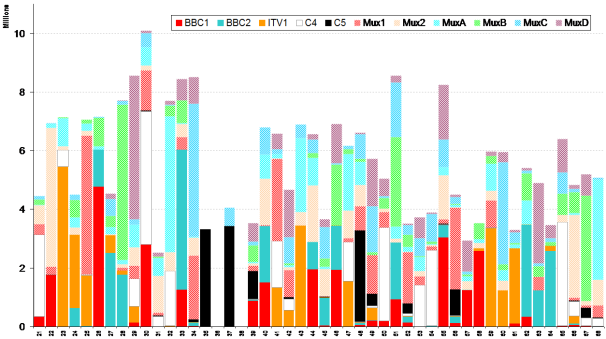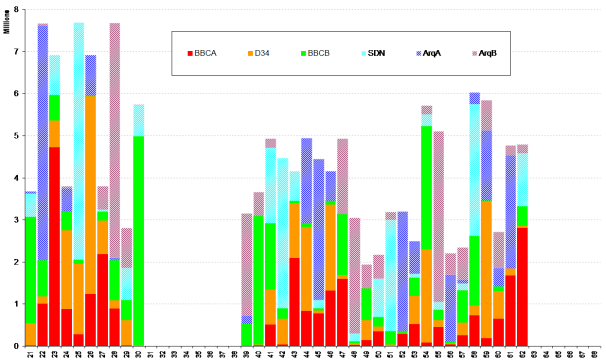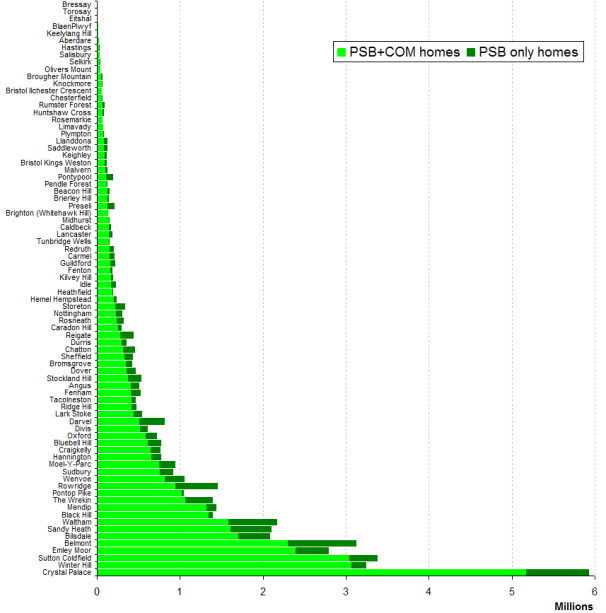The commercial multiplex after switchover: ArqA, ArqB and SDN
 Brian Butterworth published on UK Free TV
Brian Butterworth published on UK Free TV At a significant, but minority, of transmitter sites, the three commercial multiplexes, and in particular ArqA and ArqB are often held at low power for many months following the digital switchover.
The old analogue network
The following graph shows the allocation of the old analogue networks, in effect on the day before digital TV was first introduced to the UK. Along the bottom is the channel numbers from C21 up to C68, with each network coloured coded and the height of each bar representing the number of homes served.
There are 45 frequencies available (C36 was for RADAR, C38 for radio astronomy). The analogue network needed 10 frequencies per network, so in effect there are "four and a half" analogue networks: Channel 5 has less than 100% coverage.
Some frequencies were allocated exclusively to a network: C22 is used at 114 sites for BBC One analogue to 1,752,564 homes; C59, C60 and C61 at 85, 91 and 96 sites for ITV1 to 3,366,782, 1,232,976 and 2,569,576 homes, C35 and C37 are 12 and 10 Channel 5 analogue sites to 3,314,000 and 3,432,000 homes.
Another use of the frequencies is to divide the coverage into two services, such as C33 where 5 main transmitters serve 4,773,899 homes with analogue BBC TWO, but also 80 relay sites use it for analogue BBC One to 1,254,378 homes.
Finding space for ONdigital
The reason about 10 "total" frequencies are required for each full analogue network is the Inversion Effect - during certain weather conditions the analogue television signals would travel much further than usual as they bounce back to the ground due to a layer in the atmosphere acting like a signal mirror.These generous allocations allowed, back in the 1990s, the planners to provide low power digital services. This is because the system used for encoding the digital services, COFDM, looks like "snow" to an analogue service. Under inversion conditions, if the digital services "leak" to other areas, they will cause a small amount of snow to appear on an analogue picture, and COFDM has a number of systems built into it to reject interference from analogue.

This diagram shows an "analogue view" of the digital services - they appear as "noise" that will degrade an analogue picture by making it snowy.

By accepting that the digital coverage would not match the analogue service, both in terms of the number of transmitters (just 80 main ones), and the power output levels from these transmitters, and also by using carefully calculated radiation patterns (meaning the signal does not broadcast at the same level in all directions), ONdigital was able to provide a service.
Digital switchover
To provide the digital services to all homes in the UK it would then become necessary to close the analogue services and reallocate the frequencies.The diagram below shows how this has been done.

Some frequencies have been reallocated to other purposes - such as C61 to C69 for fourth generation mobile phone services, the so-called "digital dividend". (Note that C61 and C62 are shown as allocated in the diagram as the transmitters using them will be shuffled to C39 and C40 before the 4G services launch, C31-C37 are being returned to digital TV in 2012-15).
In general this means that three of the analogue network plans have been kept, and allocated to the public service broadcasting multiplexes: BBCA, D3+4 and BBCB (which is Freeview HD). This was necessary - it means that these multiplexes remain "in group" at all transmitters, so reception of these is possible without changing an existing aerial.
This means that the space for the three commercial multiplexes SDN, ArqA and ArqB have been reallocated into the effective "gaps". For this reason, the coverage of these multiplexes is much like the three most powerful multiplexes before switchover.
For this reason, whilst the network is being changed between the analogue/digital to digital-only network it is often necessary to keep the power levels for the commercial multiplex on low power, or to assign them to other temporary frequencies.
As you can see from this diagram, the outcome is that most of the main 80 transmitters will provide lower coverage for all services (light green) than they do for just the public service multiplexes (dark green).

Help with Freeview, aerials?
In this section
Monday, 30 April 2012
P Thomson: Blackburn is vertically polarised whereas Belmont is horizontal, so a horizontal aerial should act to "reject" any unwanted signals to a degree.
| link to this comment |
Friday, 7 September 2012
M
Mike Gordon11:57 AM
I like in Harefield and have lost ArqA programmes such as Sky News consistently this past week up until around 11.0 am. They literally disappear off the listings as if they were never there. A conspiracy theorist would say this is a deliberate attempt by BBC News 24 to boost their own viewing theories, or is it really just atmospherics?
| link to this comment |
Friday, 4 January 2013
D
doug smith10:18 PM
Fareham
Dave TV has been working well since the switchover. It has recently become unwatchable and freezes continuously. It was on Channel 19, but after a retune of the TV it seems now to have moved to Channel 12. Reception is still useless.
Post Code is PO175AU
| link to this comment |
doug's: mapD's Freeview map terrainD's terrain plot wavesD's frequency data D's Freeview Detailed Coverage
doug smith: Since the final change on 18th April 2012, Rowridge has been broadcasting all channels using horizontal and vertical polarisations.
However, whilst the PSB channels (which carry BBC, ITV1, Channel 4, Channel 5 etc) are the same power for both, the COM channels (ITV3, Pick TV, Dave, Film4 etc) aren't as strong horizontally. Thus, better reception of the COMs is likely by switching to vertical polarisation.
All channels are Group A which means that an aerial installed for former analogue should be OK (no need for a wideband); just switch to vertical.
| link to this comment |
Select more comments
Your comment please!